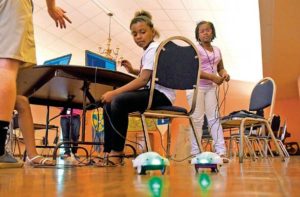The Dispatch – COLUMBUS
MSU is sponsoring their free Bulldog Bytes camp this week, with the help of St. Paul’s Episcopal Church in Columbus. The all-female summer camp is intended to bring in school-age girls who are interested in science, technology, engineering and math (STEM) fields. So far, 23 3rd~5th-grade girls are participating in the camp, where they are learning more about computer programming, problem-solving and cyber safety.
“The goal is to light a pathway for women in the state,” Sarah Lee, MSU computer science professor and director of the day camp said. “I think if you can engage them at an early age, they get that spark that ‘this is really cool. I like technology. I’m comfortable with it, and I can make this robot do things’ . . . It’s really problem-solving because programming is problem-solving,” Lee continued. “They’re learning to give commands to the robot … they’re learning the algorithmic (language).”
Campers are learning and implementing a programming language called “Snap!” to control their own “Finch” robots.
The purpose of the camp is ” . . . to teach these young women to be safe online, and to hopefully spark some interest in computer science and cyber security, so that they’ll go on to other programs and later to study it in school,” Lee said.

Winter Dismuke and Taylor Hairston, both 9, use algorithms to program a computer to command their Finch robots during STEM camp at St. Paul’s Episcopal Church in Columbus on Monday. Winter is the daughter of Shelia and Reginald Cullen. Taylor is the daughter of Nikki Mays and David Hairston. Photo by: Deanna Robinson/Dispatch Staff
Litnay Lineberry, an MSU student pursuing a PhD in computer science with a focus in K-12 STEM education, has held a major role in bringing the project to life, setting up activities and preparing material for the students to use. “It’s good to see all these kids, young females, interested and engaged in robotics and what we’re teaching them here,” Lineberry said. “What Dr. Lee is doing here is really reaching a lot of kids that may not (otherwise) have this opportunity.”
According to statistics from the National Center for Women and Information Technology, women make up only about 26 percent of the computer science workforce, even though roughly half of the United States population is female. “If males are the only ones developing new technology,” Lee said, “then we’re missing out on half of the creativity and innovation that could come from having the other half of the population at the table.”
She believes that one way to help bring parity to the industry is to catch girls’ interest early in life: “If you try to reach young women once they’re already in high school, it’s really too late,” Lee said. “They’ve already formed the ideas about what they can and can’t do or about what they want to do or don’t want to do. These elementary girls catch on really fast, faster than some of the older ones. . . For (these young girls) to be out here programming these robots to do something, it’s not a threatening environment, and that’s one reason we have the gender specific — so that they can learn and don’t feel like they have to impress the guys,” she went on to say. “One thing that I’ve noticed, too, is the guys will try to do it for them if we have the mixed-gender environment.
“It’s important that you keep them engaged. We can’t just have a summer camp, and then they go home, and there’s never anything else,” Lee said. “They come to this. We make sure they know about other things that we’re having so they can come to (events) throughout high school and then when entering college.”
Please click here for the full article.